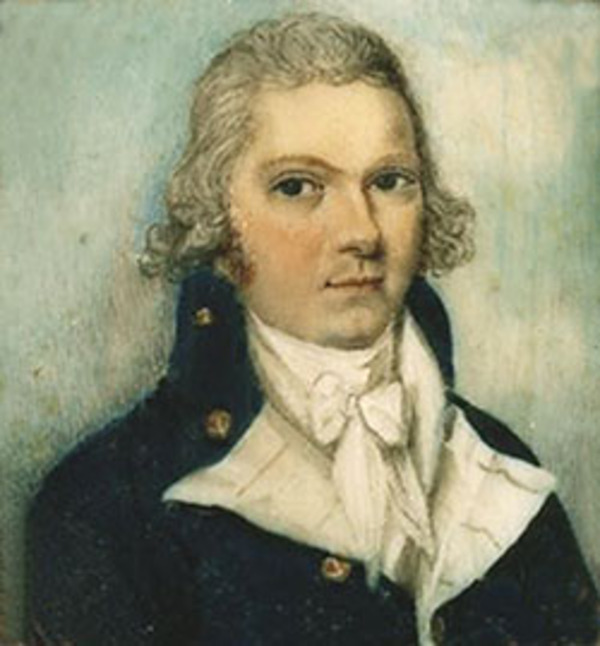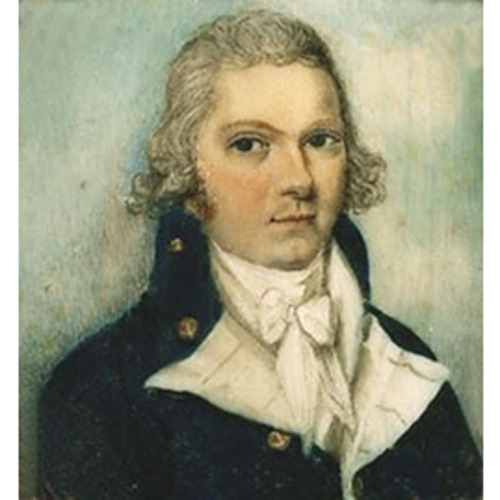
Source: Link
DUNCAN, HENRY, naval officer, office holder, and politician; b. c. 1735; m. 27 Nov. 1761 Mary French in Dartmouth, England, and they had two sons and one daughter; d. there 7 Oct. 1814.
Little can be ascertained about Henry Duncan’s early years. It is likely that he was born in Dundee, Scotland, and it is possible that he was related to Adam Duncan, victor of the battle of Camperdown. He entered the Royal Navy on 10 May 1755 as an able seaman on the Nassau, perhaps after early service with the East India Company. Following a period in the Mediterranean, the ship went to Halifax, N.S., in 1757 under Vice-Admiral Francis Holburne, as part of the planned expedition against Louisbourg, Île Royale (Cape Breton Island). Duncan passed his lieutenant’s examination on 3 Jan. 1759 and was appointed to the America. After service on several other ships he was paid off at the peace in 1763. Duncan remained on half pay for six years, during which time he was promoted commander (26 May 1768). From 1769 to 1772 he commanded the Wasp sloop on the home station. On 7 Feb. 1776 he was promoted captain and appointed flag-captain to Lord Howe in the Eagle, on board which he was present at the actions off New York City. After again serving as Howe’s flag-captain in the Victory at the third relief of Gibraltar in 1782, on 17 Jan. 1783 he was once more placed on half pay.
Duncan’s enforced leisure lasted only until 2 April, when he was appointed resident commissioner of the Halifax dockyard by Howe, now first lord of the Admiralty. As commissioner, Duncan was the representative of the Navy Board, the administrative arm of the Admiralty, and orders from London to the dockyard officers and reports from them were transmitted through him. He was in charge of the clerical and shipwright officers, organized local contracts, and negotiated with the commanders of naval vessels over the problems of refitting and storing ships. Immediately after his arrival in October he faced several difficulties. Among them were the need for shipping to England large quantities of stores evacuated from New York and Florida, a local shortage of food which required his supplying transports to take it where needed, and the influx of the loyalists, who had been arriving in Halifax since May. Duncan was instrumental in shipping the refugees elsewhere in Nova Scotia, as in April 1784 when Governor John Parr* requested him to move some persons from Port Mouton to Passamaquoddy Bay (N.B.). Later problems included the supervision of pilots for the Bay of Fundy, a scarcity of specie, a shortage of stores from England to build up the yard establishment, and, most important, the friction generated between Duncan and active commanders who wished to have a dominant role in the allotment of supplies to their ships. One quarrel stemming from this friction resulted in the dismissal of the storekeeper of the yard, George Thomas, by Sir Charles Douglas, commander-in-chief in North America. Thomas went to London to clear his name and was reinstated.
During Duncan’s long tenure the dockyard was continuously developed since Halifax had achieved a new importance with the independence of the southern colonies. A hospital was completed in 1783, the careening wharf was improved throughout the 1780s, and the dockyard property was enlarged in 1790. In the late 1780s Duncan travelled to the Miramichi River, N.B., in search of mast timber. Although this trade developed, his early reports on the availability of large masts proved to be overenthusiastic, since the trees selected were found to be decayed in the centre.
In Halifax, Duncan was a member of the North British Society, and was elected its president in 1796. He was appointed by Parr a member of the Council in 1788 but rarely attended, resigning in 1801. Duncan was also associated in a business way with a fellow Scot, Alexander Brymer, deputy paymaster of the forces. Brymer is reputed to have made £250,000 from his position. There is very little evidence about Duncan’s ability to profit similarly from his post, but he can hardly have amassed such a large amount. At the same time, however, he more than likely made some profit: he had a good deal of freedom in the awarding of local contracts and in such matters as the disposal of ships not worth repairing; moreover, his access to government hard cash must have been an advantage in a society which was often short of specie. In 1796 Lieutenant Governor Sir John Wentworth described him as “very rich,” and his occupation as “the best employment in this county or these provinces.” Duncan’s will gives evidence of comfortable if not great wealth, including a house and land at Dartmouth, N.S., and a “plantation” in St John’s, Nfld.
In the spring of 1797 Duncan returned to London for treatment of “a complaint in his head, which breaks through the upper part of his eye.” He was replaced as commissioner in 1799 by Isaac Coffin*. During his time in England Duncan, still paid as commissioner, was appointed to Coffin’s position at Sheerness, Kent. Duncan returned to Halifax on 19 Aug. 1800, sold his land, and left again for London on 11 November. On 21 Jan. 1801 he was appointed deputy controller of the Navy Board, and resigned on 20 June 1806.
The evidence for Duncan’s tenure as commissioner suggests that he was a tough and experienced officer, efficient by the standards of the age and not devoid of imagination. He enjoyed good relations with Parr and probably with Wentworth as well; moreover, he took the part of his men in the dockyard and was not cantankerous or hot-headed, as he demonstrated by maintaining his calm during the Douglas-Thomas quarrel of 1783–84. Relations between naval officers and the commissioner were, however, likely to be troublesome whatever the personalities involved because sea-going officers looked down on the administration, even in the person of formerly active officers such as Duncan. In this difficulty Duncan’s position was strengthened by his being on good terms with Charles Middleton, controller of the Navy Board during the 1780s.
Duncan’s elder son, Henry, entered the navy in 1781 but was lost at sea off Newfoundland in 1801. His daughter, Isabella, married Lieutenant Thomas Twisden in Halifax on 14 Dec. 1790. Nothing is known of his son Arthur.
National Maritime Museum, HAL/F/1–2 (Halifax Yard, Commissioners’ letterbooks, 1783–89). PRO, ADM 106/1330; 106/2027–28; 106/3174; CO 217/37: f.74; PROB 11/1562/604. The naval miscellany, ed. J. K. Laughton et al. (4v. to date, London, 1902– ), 1.
Cite This Article
R. J. B. Knight, “DUNCAN, HENRY,” in Dictionary of Canadian Biography, vol. 5, University of Toronto/Université Laval, 2003–, accessed April 21, 2025, https://www.biographi.ca/en/bio/duncan_henry_5E.html.
The citation above shows the format for footnotes and endnotes according to the Chicago manual of style (16th edition). Information to be used in other citation formats:
| Permalink: | https://www.biographi.ca/en/bio/duncan_henry_5E.html |
| Author of Article: | R. J. B. Knight |
| Title of Article: | DUNCAN, HENRY |
| Publication Name: | Dictionary of Canadian Biography, vol. 5 |
| Publisher: | University of Toronto/Université Laval |
| Year of revision: | 1983 |
| Access Date: | April 21, 2025 |



